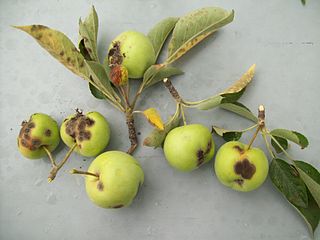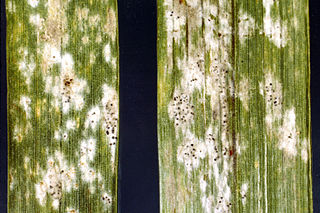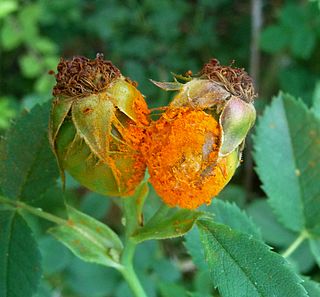Related Research Articles

Domestication is a sustained multi-generational relationship in which humans assume a significant degree of control over the reproduction and care of another group of organisms to secure a more predictable supply of resources from that group. A broader biological definition is that it is a coevolutionary process that arises from a mutualism, in which one species constructs an environment where it actively manages both the survival and reproduction of another species in order to provide the former with resources and/or services. The domestication of plants and animals by humans was a major cultural innovation ranked in importance with the conquest of fire, the manufacturing of tools, and the development of verbal language.

Plant pathology is the scientific study of diseases in plants caused by pathogens and environmental conditions. Organisms that cause infectious disease include fungi, oomycetes, bacteria, viruses, viroids, virus-like organisms, phytoplasmas, protozoa, nematodes and parasitic plants. Not included are ectoparasites like insects, mites, vertebrate, or other pests that affect plant health by eating plant tissues. Plant pathology also involves the study of pathogen identification, disease etiology, disease cycles, economic impact, plant disease epidemiology, plant disease resistance, how plant diseases affect humans and animals, pathosystem genetics, and management of plant diseases.

Apple scab is a common disease of plants in the rose family (Rosaceae) that is caused by the ascomycete fungus Venturia inaequalis. While this disease affects several plant genera, including Sorbus, Cotoneaster, and Pyrus, it is most commonly associated with the infection of Malus trees, including species of flowering crabapple, as well as cultivated apple. The first symptoms of this disease are found in the foliage, blossoms, and developing fruits of affected trees, which develop dark, irregularly-shaped lesions upon infection. Although apple scab rarely kills its host, infection typically leads to fruit deformation and premature leaf and fruit drop, which enhance the susceptibility of the host plant to abiotic stress and secondary infection. The reduction of fruit quality and yield may result in crop losses of up to 70%, posing a significant threat to the profitability of apple producers. To reduce scab-related yield losses, growers often combine preventive practices, including sanitation and resistance breeding, with reactive measures, such as targeted fungicide or biocontrol treatments, to prevent the incidence and spread of apple scab in their crops.

Venturia inaequalis is an ascomycete fungus that causes the apple scab disease.

Blumeria graminis is a fungus that causes powdery mildew on grasses, including cereals. It is the only species in the genus Blumeria. It has also been called Erysiphe graminis and Oidium monilioides or Oidium tritici.
Clayton Oscar Person, was recognized internationally as an authority on the genetics of host-parasite relations. He was born and raised in Aylesbury, Saskatchewan, Canada and died in Vancouver, British Columbia, Canada. His writings have made a major contribution to the development of a rigorous theoretical basis for our understanding of how the genetic structure of parasitic populations interacts with that of their host populations. This was known as the gene-for-gene relationship. His theoretical methods have been applied widely in the practical management of parasitic diseases in agriculture and forestry.
Raoul A. Robinson was a Canadian/British plant scientist with more than forty years of wide-ranging global experience in crop improvement for both commercial and subsistence agriculture. He is best known for his application of system theory to crop pathosystems and the elucidation of the concepts of horizontal and vertical resistance and their implication on breeding for durable resistance.
The gene-for-gene relationship was discovered by Harold Henry Flor who was working with rust (Melampsora lini) of flax (Linum usitatissimum). Flor showed that the inheritance of both resistance in the host and parasite ability to cause disease is controlled by pairs of matching genes. One is a plant gene called the resistance (R) gene. The other is a parasite gene called the avirulence (Avr) gene. Plants producing a specific R gene product are resistant towards a pathogen that produces the corresponding Avr gene product. Gene-for-gene relationships are a widespread and very important aspect of plant disease resistance. Another example can be seen with Lactuca serriola versus Bremia lactucae.
The term vertical resistance, used commonly in context of plant selection, was first used by J.E. Vanderplank to describe single-gene resistance. This contrasted the term horizontal resistance which was used to describe many-gene resistance. Raoul A. Robinson further refined the definition of vertical resistance, emphasizing that in vertical resistance there are single genes for resistance in the host plant, and there are also single genes for parasitic ability in the parasite. This phenomenon is known as the gene-for-gene relationship, and it is the defining character of vertical resistance.
In genetics, the term horizontal resistance was first used by J.E. Vanderplank to describe many-gene resistance, which is sometimes also called generalized resistance. This contrasts with the term vertical resistance which was used to describe single-gene resistance. Raoul A. Robinson further refined the definition of horizontal resistance. Unlike vertical resistance and parasitic ability, horizontal resistance and horizontal parasitic ability are entirely independent of each other in genetic terms.
This is a glossary of some of the terms used in phytopathology.

Thielaviopsis basicola is the plant-pathogen fungus responsible for black root rot disease. This particular disease has a large host range, affecting woody ornamentals, herbaceous ornamentals, agronomic crops, and even vegetable crops. Examples of susceptible hosts include petunia, pansy, poinsettia, tobacco, cotton, carrot, lettuce, tomato, and others. Symptoms of this disease resemble nutrient deficiency but are truly a result of the decaying root systems of plants. Common symptoms include chlorotic lower foliage, yellowing of plant, stunting or wilting, and black lesions along the roots. The lesions along the roots may appear red at first, getting darker and turning black as the disease progresses. Black root lesions that begin in the middle of a root can also spread further along the roots in either direction. Due to the nature of the pathogen, the disease can easily be identified by the black lesions along the roots, especially when compared to healthy roots. The black lesions that appear along the roots are a result of the formation of chlamydospores, resting spores of the fungus that contribute to its pathogenicity. The chlamydospores are a dark brown-black color and cause the "discoloration" of the roots when they are produced in large amounts.
Genetic erosion is a process where the limited gene pool of an endangered species diminishes even more when reproductive individuals die off before reproducing with others in their endangered low population. The term is sometimes used in a narrow sense, such as when describing the loss of particular alleles or genes, as well as being used more broadly, as when referring to the loss of a phenotype or whole species.
Resistance genes (R-Genes) are genes in plant genomes that convey plant disease resistance against pathogens by producing R proteins. The main class of R-genes consist of a nucleotide binding domain (NB) and a leucine rich repeat (LRR) domain(s) and are often referred to as (NB-LRR) R-genes or NLRs. Generally, the NB domain binds either ATP/ADP or GTP/GDP. The LRR domain is often involved in protein-protein interactions as well as ligand binding. NB-LRR R-genes can be further subdivided into toll interleukin 1 receptor (TIR-NB-LRR) and coiled-coil (CC-NB-LRR).

Plant disease resistance protects plants from pathogens in two ways: by pre-formed structures and chemicals, and by infection-induced responses of the immune system. Relative to a susceptible plant, disease resistance is the reduction of pathogen growth on or in the plant, while the term disease tolerance describes plants that exhibit little disease damage despite substantial pathogen levels. Disease outcome is determined by the three-way interaction of the pathogen, the plant and the environmental conditions.

Host–parasite coevolution is a special case of coevolution, where a host and a parasite continually adapt to each other. This can create an evolutionary arms race between them. A more benign possibility is of an evolutionary trade-off between transmission and virulence in the parasite, as if it kills its host too quickly, the parasite will not be able to reproduce either. Another theory, the Red Queen hypothesis, proposes that since both host and parasite have to keep on evolving to keep up with each other, and since sexual reproduction continually creates new combinations of genes, parasitism favours sexual reproduction in the host.

Evolving digital ecological networks are webs of interacting, self-replicating, and evolving computer programs that experience the same major ecological interactions as biological organisms. Despite being computational, these programs evolve quickly in an open-ended way, and starting from only one or two ancestral organisms, the formation of ecological networks can be observed in real-time by tracking interactions between the constantly evolving organism phenotypes. These phenotypes may be defined by combinations of logical computations that digital organisms perform and by expressed behaviors that have evolved. The types and outcomes of interactions between phenotypes are determined by task overlap for logic-defined phenotypes and by responses to encounters in the case of behavioral phenotypes. Biologists use these evolving networks to study active and fundamental topics within evolutionary ecology.
The Vertifolia effect is a well documented phenomenon in the fields of plant breeding and plant pathology. It is characterized by the erosion of a crop’s horizontal resistance to disease during a breeding cycle due to the presence of strong vertical resistance, characterized by the presence of R genes. This effect was observed in late blight of potato. This phenomenon was first described by J.E. Van der Plank in his 1963 book Plant Disease: Epidemics and Control. Van der Plank observed that under artificial selection the potato variety Vertifolia had stronger vertical resistance to the potato late blight pathogen, Phytophthora infestans, as measured by the presence of specific R genes. However, when the pathogen overcame these R genes Vertifolia exhibited a greater loss of horizontal resistance than varieties with fewer R genes and lower vertical resistance. This effect suggests that when a pathogen evolves an avirulence gene to counteract a variety’s R gene, that variety will be more susceptible to the pathogen than other varieties.

The study of gene-for-gene interactions uncovers genetic components, evolutionary impacts, and ecological/economic implications between rust fungi and plants. Rust fungi utilize the gene-for-gene interaction to invade host plants. Conversely, host plants utilize the gene-for-gene interaction to prevent invasion of rust fungi.

Dieter Ebert is professor for Zoology and Evolutionary Biology at the Zoological Institute at the University of Basel in Basel, Switzerland. He is an evolutionary ecologist and geneticist, known for his research on host–pathogen interaction and coevolution, mainly using the model system Daphnia and its parasites.
References
- 1 2 3 4 Robinson, Raoul A. (1987) Host Management in Crop Pathosystems. Macmillan, New York, Collier-Macmillan, London, 263pp
- 1 2 3 4 5 6 7 Robinson, R.A.(2010) Self-Organizing Agro-Ecosystems; Sharebooks Publishing http://www.sharebookspublishing.com
- ↑ Flor, H.H. (1942); “Inheritance of pathogenicity in Melampsora lini.” Phytopath., 32; 653-669.
- 1 2 3 4 5 Vanderplank, J.E. (1963); “Plant Diseases; Epidemics and Control.” Academic Press, New York & London, 349pp.
- 1 2 3 Robinson, R.A. (1976); “Plant Pathosystems.” Springer-Verlag, Berlin, Heidelberg, New York, 184pp.
- 1 2 3 Robinson, R.A. (1996) Return to Resistance; Breeding Plants to Reduce Pesticide Dependence”. agAccess, Davis, California, 480pp.
- ↑ Person, C.O. (1959); “Gene-for-gene relationships in host-parasite systems.” Can. J. Bot. 37; 1101-1130.
- ↑ Vanderplank, J.E. (1968); “Disease Resistance in Plants.” Academic Press, New York & London, 206pp.